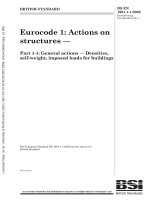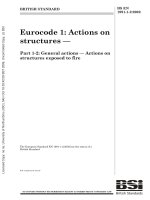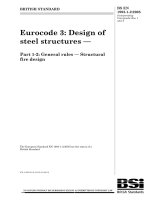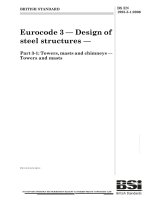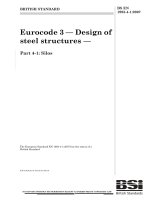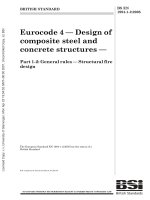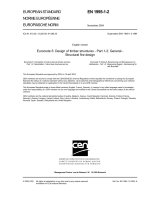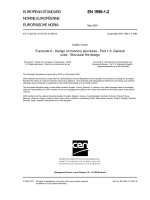Bsi bs au 050 1 1 2 2001 (iso 17269 2000)
Bạn đang xem bản rút gọn của tài liệu. Xem và tải ngay bản đầy đủ của tài liệu tại đây (613.84 KB, 16 trang )
BRITISH STANDARD AUTOMOBILE SERIES
|
|
|
|
|
|
|
|
|
|
|
|
|
|
Passenger car tyres Ð
Methods for measuring
rolling circumference Ð
Loaded new tyres
|
|
|
|
|
|
|
|
|
|
|
|
|
|
|
|
|
|
|
|
|
|
|
|
|
|
|
|
|
|
|
|
|
|
|
|
|
|
|
|
|
|
|
|
|
|
|
|
|
|
|
|
|
|
|
|
|
|
|
|
|
|
|
|
|
|
|
|
|
|
|
|
|
|
|
|
|
|
|
|
|
|
|
|
|
|
|
|
|
|
|
|
|
|
|
|
|
|
|
|
|
|
IC S
83 . 1 60 . 1 0
|
|
|
|
|
|
|
|
NO COPYING WITHOUT BSI PERMISSION EXCEPT AS PERMITTED BY COPYRIGHT LAW
|
|
|
|
|
BS AU
50.1.1.2:2001
ISO 17269:2000
BS AU 50.1.1.2:2001
National foreword
This British Standard reproduces verbatim ISO 17269:2000 and implements it as the
UK national standard.
The UK participation in its preparation was entrusted to Technical Committee
AUE/4, Tyres and wheels for motor vehicles, which has the responsibility to:
Ð aid enquirers to understand the text;
Ð present to the responsible international/European committee any enquiries
on the interpretation, or proposals for change, and keep the UK interests
informed;
Ð monitor related international and European developments and promulgate
them in the UK.
A list of organizations represented on this committee can be obtained on request to
its secretary.
Cross-references
The British Standards which implement international publications referred to in this
document may be found in the BSI Standards Catalogue under the section entitled
ªInternational Standards Correspondence Indexº, or by using the ªFindº facility of
the BSI Standards Electronic Catalogue.
A British Standard does not purport to include all the necessary provisions of a
contract. Users of British Standards are responsible for their correct application.
Compliance with a British Standard does not of itself confer immunity
from legal obligations.
Summary of pages
This document comprises a front cover, an inside front cover, the ISO title page,
pages ii to iv, pages 1 to 8, an inside back cover and a back cover.
The BSI copyright notice displayed in this document indicates when the document
was last issued.
This British Standard, having
been prepared under the
direction of the Engineering
Sector Committee, was published
under the authority of the
Standards Committee and comes
into effect on 1 5 April 2001
BSI 04-2001
ISBN 0 580 36849 1
Amendments issued since publication
Amd. No.
Date
Comments
INTERNATIONAL
STANDARD
BS AU 50.1.1.2:2001
I SO
1 7269
First edition
2000-1 2-01
Passen g er car tyres — M eth od s fo r
m easu ri n g rol l i n g ci rcu m feren ce — Lo ad ed
n ew tyres
Pneumatiques pour voitures particulières — Méthodes de mesure de la
circonférence de roulement — Pneumatiques neufs en charge
Reference number
ISO 1 7269:2000(E)
BS AU 50.1.1.2:2001
I SO 96271 : (0002 ) E
ii
BS AU 50.1.1.2:2001
I SO 96271 : (0002 ) E
Con ten ts
Page
Foreword . . . . . . . . . . . . . . . . . . . . . . . . . . . . . . . . . . . . . . . . . . . . . . . . . . . . . . . . . . . . . . . . . . . . . . . . . . . . . . . . . . . . . . . . . . . . . . . . . . . . . . . . . . . . . . . . . . . . . . . . . . . . . . . . . . . . . . . . . . . . . . . . . . . . . . . . . . . . . . . . . . . . . i v
1
Scope . . . . . . . . . . . . . . . . . . . . . . . . . . . . . . . . . . . . . . . . . . . . . . . . . . . . . . . . . . . . . . . . . . . . . . . . . . . . . . . . . . . . . . . . . . . . . . . . . . . . . . . . . . . . . . . . . . . . . . . . . . . . . . . . . . . . . . . . . . . . . . . . . . . . . . . . . . . . . . 1
2
N orm ati ve referen ce . . . . . . . . . . . . . . . . . . . . . . . . . . . . . . . . . . . . . . . . . . . . . . . . . . . . . . . . . . . . . . . . . . . . . . . . . . . . . . . . . . . . . . . . . . . . . . . . . . . . . . . . . . . . . . . . . . . . . . . . . . . . . . . . . . . . . . 1
3
Term s an d d efi n i ti on s . . . . . . . . . . . . . . . . . . . . . . . . . . . . . . . . . . . . . . . . . . . . . . . . . . . . . . . . . . . . . . . . . . . . . . . . . . . . . . . . . . . . . . . . . . . . . . . . . . . . . . . . . . . . . . . . . . . . . . . . . . . . . . . . . . . 1
4
Dru m m eth od . . . . . . . . . . . . . . . . . . . . . . . . . . . . . . . . . . . . . . . . . . . . . . . . . . . . . . . . . . . . . . . . . . . . . . . . . . . . . . . . . . . . . . . . . . . . . . . . . . . . . . . . . . . . . . . . . . . . . . . . . . . . . . . . . . . . . . . . . . . . . . . . . . 2
5
Test m eth od u si n g veh i cl e . . . . . . . . . . . . . . . . . . . . . . . . . . . . . . . . . . . . . . . . . . . . . . . . . . . . . . . . . . . . . . . . . . . . . . . . . . . . . . . . . . . . . . . . . . . . . . . . . . . . . . . . . . . . . . . . . . . . . . . . . . . . 4
An n exe A
(informative)
Test eq u i pm en t tol eran c es . . . . . . . . . . . . . . . . . . . . . . . . . . . . . . . . . . . . . . . . . . . . . . . . . . . . . . . . . . . . . . . . . . . . . . . . . . . . . . . . . . . . . . . . . . . . . . . . 7
B i bl i og raph y . . . . . . . . . . . . . . . . . . . . . . . . . . . . . . . . . . . . . . . . . . . . . . . . . . . . . . . . . . . . . . . . . . . . . . . . . . . . . . . . . . . . . . . . . . . . . . . . . . . . . . . . . . . . . . . . . . . . . . . . . . . . . . . . . . . . . . . . . . . . . . . . . . . . . . . . . . . . . . . . 8
iii
BS AU 50.1.1.2:2001
I SO 96271 : (0002 ) E
Foreword
ISO (the International Organization for Standardization) is a worldwide federation of national standards bodies (ISO
member bodies). The work of preparing International Standards is normally carried out through ISO technical
committees. Each member body interested in a subject for which a technical committee has been established has
the right to be represented on that committee. International organizations, governmental and non-governmental, in
liaison with ISO, also take part in the work. ISO collaborates closely with the International Electrotechnical
Commission (IEC) on all matters of electrotechnical standardization.
International Standards are drafted in accordance with the rules given in the ISO/IEC Directives, Part 3.
Draft International Standards adopted by the technical committees are circulated to the member bodies for voting.
Publication as an International Standard requires approval by at least 75 % of the member bodies casting a vote.
Attention is drawn to the possibility that some of the elements of this International Standard may be the subject of
patent rights. ISO shall not be held responsible for identifying any or all such patent rights.
International Standard ISO 1 7269 was prepared by Technical Committee ISO/TC 31 ,
Subcommittee SC 3, Passenger car tyres and rims.
Annex A of this International Standard is for information only.
iv
Tyres, rims and valves,
BS AU 50.1.1.2:2001
I N TEN R ATI ON AL TSAN D ADR
I SO 96271 : (0002 ) E
Passen g er car tyres — M eth od s fo r m easu ri n g rol l i n g
ci rcu m feren ce — Lo ad ed n ew tyres
1
Scope
This International Standard specifies two methods for measuring, under loaded conditions, the rolling
circumference and revolutions per unit distance (kilometres) of new tyres for use on passenger cars. The first is a
drum method that consists of loading a test tyre mounted on a free axle against a driven road wheel, or drum, of
specified diameter. The second involves using a vehicle whose drive axle is equipped with the test tyres driven on
a straight, paved road.
This International Standard is applicable to all passenger car tyres. However, the values obtained from the
measurements are not intended to be used as benchmarks for performance or quality.
2
N o rm ati ve referen ce
The following normative document contains provisions which, through reference in this text, constitute provisions of
this International Standard. For dated references, subsequent amendments to, or revisions of, any of these
publications do not apply. However, parties to agreements based on this International Standard are encouraged to
investigate the possibility of applying the most recent edition of the normative document indicated below. For
undated references, the latest edition of the normative document referred to applies. Members of ISO and IEC
maintain registers of currently valid International Standards.
ISO 4000-1 ,
3
Passenger car tyres and rims — Part 1: Tyres (metric series).
Term s an d d efi n i ti o n s
For the purposes of this International Standard, the following terms and definitions apply.
3. 1
revo l u ti on s per u n i t d i st an ce
number of tyre revolutions, and parts of revolutions, that occur when the (axle) centre of the tyre is moved a unit
distance of exactly 1 km; the number of tyre revolutions per kilometre is calculated as one divided by the tyre rolling
circumference (in millimetres) multiplied by 1 0 6
3. 2
ro l l i n g ci rcu m feren ce of tyre
Cr
distance covered by the tyre during one complete revolution
1
BS AU 50.1.1.2:2001
I SO 96271 : (0002 ) E
4
Dru m m eth od
4. 1
Pri n ci pl e
A test tyre mounted on a free axle is loaded against a driven road wheel (drum) of specified diameter. The value of
the rolling circumference is determined for a specified speed, the tyre and drum revolutions are counted and used
in the formula, and the formula then used to determine the tyre’s rolling circumference.
4. 2
4. 2. 1
Test d ru m speci fi cati on s
Di am eter
The test drum shall have a diameter of at least 1 ,20 m, with a free axle capable of holding and loading a tyre
against the driven drum. Care shall be taken to avoid galloping during measurements.
4. 2. 2
Su rfac e
The surface of the drum should preferably be of smooth steel. In cases where a textured drum surface is used, this
shall be noted in the test report. The surface of the drum shall be kept clean.
4. 2. 3
Wi d th
The width of the drum test surface shall exceed that of the test tyre tread.
4. 3
Th erm al en vi ron m en t
The test should preferably be carried out at a reference room temperature of 25 °C. However, it may be performed
in the range 20 °C to 30 °C. No temperature correction is required.
4. 4
Speed
In order to establish a basic reference for rolling circumference for all tyres, the drum velocity shall be 80 km/h.
For radial tyres, linear assumption is allowed for the relation between rolling circumference values and the speed of
the tyre in the range 80 km/h ? 50 km/h, and the rolling circumference may be evaluated at 80 km/h by linear
interpolation within that range.
4. 5
Ac cu rac y
The minimum number of impulses ( Ni ) per revolution of both the tyre and the drum shall be 1 0. The total number of
impulses during the time of measurement should be greater than 1 000.
4. 6
4. 6. 1
Test tyre param eters
Lo ad
The standard test loads shall be computed from 80 % of the load capacity, corresponding to the load index (LI)
moulded on the tyre sidewall, or 80 % of the maximum permissible load.
Load application shall be kept normal to the test surface and shall pass within 5 mrad of the wheel centre.
2
BS AU 50.1.1.2:2001
I SO 96271 : (0002 ) E
4. 6. 2
Al i g n m en t
4. 6. 2. 1
Sl i p an g l e
The plane of the tyre shall be parallel, within 3 mrad, to the direction of the test surface motion.
4. 6. 2. 2
Cam ber an g l e
The plane of the wheel shall be normal, within 1 0 mrad, to the test surface.
4. 7
I n fl ati on pressu re
The inflation pressure of the test tyre at ambient temperature shall be 30 kPa less than the reference pressure for
the tyre categories specified in annex B of ISO 4000-1 :2000. The pressure may be either regulated or capped. For
tyres not specified in ISO 4000-1 , the reference inflation pressure shall be that given by the tyre manufacturer.
4. 8
Ri m s
The rims used in the test should be of a size and type approved by the tyre manufacturer for use with the test tyres
in highway service. If such rims are not available, or the information is unknown, a standard measuring rim, or the
rim nearest to it, shall be used in the test.
4. 9
Proced u re
a) To ensure repeatability of measurements, an initial break-in and cooling period can be necessary prior to the
start of the test. Carry out this break-in on a test drum of at least 1 ,20 m, for a period of not less than one hour,
at a minimum velocity of 80 km/h, and at the load and inflation pressure specified in 4.6.1 and 4.7.
b) For future comparisons, record the overall diameter of the new tyre after the break-in.
c) Allow the tyre to stand, inflated, in the test area thermal environment in order for it to achieve thermal
equilibrium, generally reached after 3 h.
d) Adjust the inflation pressure to that specified in 4.7. and after about 1 0 min, verify the load is as specified in
4.6.1 .
e) Rotate the drum at the test speed for approximately 30 min to warm up the tyre. After warm-up, the inflation
pressure may not be readjusted under capped-pressure conditions, and the test shall be run with pressure
build-up to simulate normal service conditions. The values obtained under regulated pressure conditions will
be similar to those obtained using capped pressure.
4. 1 0
Cal cu l ati on
Record the number of revolutions and parts of revolutions of the drum occurring during a time duration, T,
taking care to ensure that, for both tyre and drum, the total number of impulses during T is greater than 1 000.
4. 1 0. 1
4. 1 0. 2
Calculate the test tyre’s rolling circumference, Cr, in millimetres, using the formula:
C r ? 2?
? Nd ?
?
? Nt ?
?
R
where
Nd is the number of revolutions of the drum;
Nt is the number of revolutions of the tyre;
R
is the radius of the drum, in millimetres.
3
BS AU 50.1.1.2:2001
I SO 96271 : (0002 ) E
4. 1 0. 3
Results obtained with different drum diameters can be compared using the following empirical formula:
C r, R 02 ? K ? C r, R 01
with
K?
? ?R
?
?
?
1
R 2 ? ? R 2 ? rT ? ?
?
??
? R1 ? r T ?
?1
30
where
R1
is the radius of drum 1 , in millimetres;
R2
is the radius of drum 2, in millimetres;
rT
is the nominal tyre radius, in millimetres;
Cr, R01
is the rolling circumference measured on drum 1 , in millimetres;
Cr, R02
is the rolling circumference measured on drum 2, in millimetres.
Results obtained using the formula given in 4.1 0.2 can be correlated with those obtained by road
simulation on a flat surface, which is carried out using the following empirical formula:
4. 1 0. 4
C rF ? K ? C rD
with
K?
?
? R1
?
R1
? rT
?
?
?
?1
30
where
R 1 is the radius of drum 1 , in millimetres;
r T is the nominal tyre radius, in millimetres;
CrD is the rolling circumference measured on the drum, in millimetres;
CrF is the rolling circumference measured on a flat surface, in millimetres.
5
5. 1
Test m eth o d u si n g veh i cl e
Pri n ci pl e
This method consists of driving a typical vehicle whose drive axle is fitted with the test tyres at a constant speed on
a straight, level, paved road, and counting the number of tyre revolutions, or parts of revolutions, that occur during
the traversal of an accurately measured distance.
4
BS AU 50.1.1.2:2001
I SO 96271 : (0002 ) E
5. 2
5. 2. 1
Con d i ti on s
Cou rse
The test course shall be a level, straight section of smooth, dry road, whose surface is of either asphalt or concrete
pavement of medium roughness. The maximum longitudinal and transverse gradient of the road shall be 1 %. The
length of the course should preferably be 500 m, but may be longer depending on the accuracy of the test
equipment (see 5.4).
The length of the test course, expressed in metres, shall be measured to within 0,1 %.
There shall be an approach road at both ends of the test course to allow the course to be entered at the test speed.
5. 2. 2
Weath er
The ambient temperature shall be between 5 °C and 30 °C. However, any asphaltic surface shall be sufficiently
cool so that the surface is not tacky. The wind speed shall not exceed 7 m/s.
5. 3
Speed
The test speed shall be in the range 80 km/h ? 2 km/h.
For radial tyres, linear assumption is allowed for the relation between rolling circumference values and the speed of
the tyre in the range 80 km/h ? 50 km/h.
5. 4
Accu racy
The minimum number of impulses per revolution shall be 1 6. The overall error in the revolution-counting
equipment, including start and stop errors, shall not exceed 0,1 %.
5. 5
Veh i cl e
The test vehicle shall be representative of the size of vehicle normally fitted with tyres the same size as those being
tested.
Because most speedometers and odometers are actuated from the drive-shaft, the test tyres shall be fitted to the
drive axle. For four-wheel drive vehicles, one or the other of the drive axles shall be disengaged during the test.
5. 6
5. 6. 1
Test tyre an d ri m param eters
Tyres
The tyres shall be a matched set of the same size, designation, type and brand, having inflated, unloaded overall
diameters within 0,5 % of each other.
For future comparisons, record the overall diameter of the new tyres, measured according to ISO 4000-1 .
5. 6. 2
Lo ad
The load on the drive axle shall be 80 % of the maximum rated tyre load multiplied by the number of tyres on the
axle, to within ? 2 %.
The tyres’ maximum load capacity corresponds to the LI moulded on the sidewall of the tyre. If this is not marked,
use the maximum permissible tyre load capacity.
5
BS AU 50.1.1.2:2001
I SO 96271 : (0002 ) E
5. 6. 3
I n fl ati o n p res su re
The inflation pressure of the test tyres at ambient temperature shall be 30 kPa less than the reference pressure for
the tyre categories specified in annex B of ISO 4000-1 :2000. For tyres not specified in ISO 4000-1 , the reference
inflation pressure shall be that given by the tyre manufacturer.
5. 6. 4
Ri m s
The rims used in the test should be of a size and type approved by the tyre manufacturer for use with the test tyres
in highway service. If such rims are not available, or the information is unknown, a standard measuring rim, or the
rim nearest to it, shall be used in the test.
5. 7
Proced u re
a) Prior to the test, break in and condition the tyres by running for at least half an hour at an average speed of
approximately 80 km/h at the specified load and inflation pressure.
b) Immediately after conditioning, run the test at the speed and on the course specified.
c) Limit acceleration, braking, and steering to an absolute minimum during the measurements.
d) Record the number of revolutions, and parts of revolutions, of the right and left test wheels, during the time
taken for the vehicle to complete the test course.
e) Repeat the test twice in both directions. If the number of revolutions for each wheel on the second run differs
from the first in the same direction by more than 0,2 %, repeat the test until two runs are obtained in each
direction within this tolerance.
5. 8
Cal cu l ati on
Calculate for each of the eight readings (i.e. four runs for each drive wheel) according to 4.3.9 e) and
average the eight calculations to obtain the rated value.
5. 8. 1
To determine the rolling circumference, divide the test course length (in metres) by the number of
revolutions measured and multiply this by 1 0 3. Round this value to the nearest unit.
5. 8. 2
6
BS AU 50.1.1.2:2001
I SO 96271 : (0002 ) E
An n ex A
(informative)
Test eq u i pm en t tol eran ces
These limits are given in order to achieve suitable levels of repeatable test results that can be correlated among
various test laboratories. The tolerances are not intended to represent a complete set of engineering specifications
for test equipment, but to serve as guidelines for achieving reliable test results.
Excluding perturbations induced by non-uniform tyres and rims, the test equipment should be capable of checking
the test variables within the following limits:
?
?
?
?
?
tyre loading: ? 50 N;
inflation pressure: ? 5 kPa;
surface velocity: ? 0,5 km/h;
drum measurement accuracy: ? 1 mm;
tyre angular velocity: ? 0,2 %.
7
BS AU 50.1.1.2:2001
I SO 96271 : (0002 ) E
B i bl i og raph y
[1 ]
I SO 1 0 1 91 ,
[2 ]
I S O 42 2 3 - 1 ,
8
Passenger car tyres — Verifying tyre capabilities — Laboratory test methods
.
Definitions ofsome terms used in the tyre industry — Part 1: Pneumatic tyres
.
BS AU
50.1.1.2:2001
ISO 17269:2000
|
|
|
|
|
|
|
|
|
BSI Ð British Standards Institution
|
|
|
|
|
|
|
BSI is the
independent national
body responsible
for preparing British Standards.
It
|
|
presents the
UK view on standards
in Europe
and at the
international level.
It is
|
|
|
|
|
incorporated by Royal Charter.
Revisions
|
|
British Standards are
updated by amendment or revision.
Users
of British Standards
|
|
should make
sure
that they possess
the
latest amendments
or editions.
|
|
|
It is the
constant aim of BSI
to
improve
the
quality of our products
and services.
We
|
|
would be
grateful if anyone
finding
an inaccuracy or ambiguity while
using
this
|
|
|
|
|
British Standard would inform the
the
identity of which can be
Fax:
02 0
8996
Secretary of the
found on the
inside
technical
front cover.
committee
Tel:
020
responsible,
8996
9000.
7400.
|
|
|
BSI offers members
an individual
updating
service
called PLUS
which ensures
that
|
|
|
|
|
|
subscribers
automatically receive
the
latest editions
of standards.
Buying standards
|
|
|
|
|
|
Orders for all
addressed to
are
also
BSI,
international
and foreign standards
Customer Services.
available
from the
BSI
Tel:
02 0 8996 9001 .
website
publications
Fax:
should be
02 0 8996 7001 .
Standards
at http: //www. bsi-global. com.
|
|
In response
to
orders
for international
standards,
it is
BSI
policy to
supply the
BSI
|
|
implementation of those
that have
been published as
British Standards,
unless
|
|
otherwise
|
Information on standards
|
|
requested.
|
|
|
|
|
|
BSI provides a wide
range
standards through its
BSI electronic
of information on national,
Library and its
information services
Technical Help
are
also
European and international
to
available
Exporters
which give
Service.
details
Various
on all
its
|
|
products and services.
Contact the
Information Centre.
Tel:
020 8996 71 1 1 .
|
|
Fax:
02 0 8996 7048.
|
|
|
|
|
|
|
|
Subscribing members of BSI
receive
these
Fax:
are
substantial discounts
and other benefits
02 0 8996 7001 .
kept up
on the
to
date
purchase
contact Membership
with standards
price
Administration.
Further information about BSI
developments
of standards.
is
Tel:
available
For details
020
on the
and
of
8996 7002.
BSI
website
|
|
|
|
|
|
at http: //www. bsi-global. com.
Copyright
|
|
Copyright subsists in all
BSI
publications.
BSI
also
holds
the
copyright,
in the
UK,
of
|
|
|
|
|
the
publications of the
under the
Copyright,
international standardization bodies.
Designs
and Patents
Act 1 988
no
Except as
extract may be
permitted
reproduced,
stored in a retrieval system or transmitted in any form or by any means
± electronic,
|
|
photocopying,
recording or otherwise
± without prior written permission from BSI.
|
|
|
This does not preclude
the
free
use,
in the
course
of implementing
the
standard,
|
|
necessary details such as
symbols,
and size,
type
or grade
designations.
If these
|
|
|
|
details
are
to
be
used for any other purpose
written permission of BSI
must be
than implementation then the
prior
obtained.
|
|
If permission is
granted,
the
terms
may include
royalty payments
or a licensing
|
|
agreement.
Details
|
|
|
|
|
|
|
|
BSI
|
389
Chiswick High Road
|
|
London
|
|
W4
4AL
|
|
|
|
|
|
|
Tel:
02 0 8996 7070.
and advice
can be
obtained from the
Copyright Manager.
of

